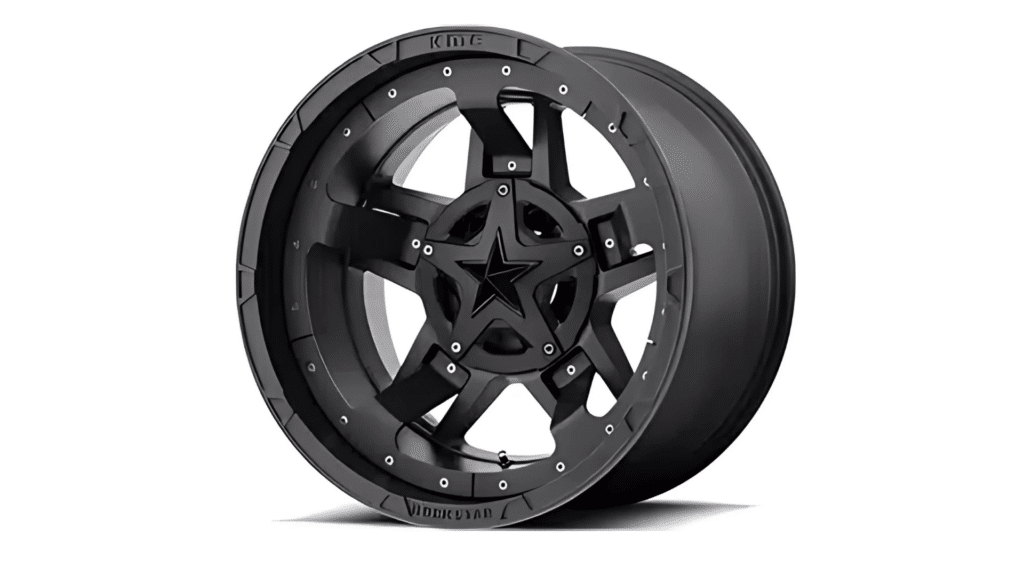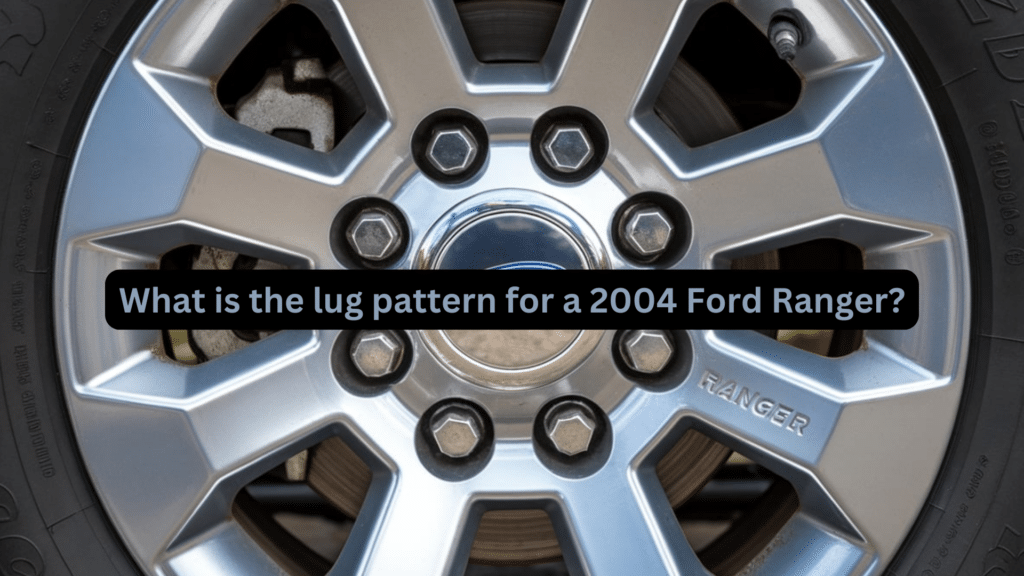If you’re here, you’re probably staring at your Ranger’s wheels and wondering about the lug pattern. Trust me, I get it – finding the right wheel fit can be frustrating, especially with a truck that’s nearly 20 years old.
In this article, I’ll give you the exact lug pattern specs for your 2004 Ford Ranger. But I won’t stop there. You’ll also learn why these measurements matter and how to double-check them yourself. No more guessing or buying the wrong wheels.
I’ve spent years working on Rangers, and I know these trucks inside and out. Whether you’re upgrading your wheels, replacing a damaged one, or just wanting to know your vehicle better, you’ll find what you need here.
Let’s get your Ranger sorted out with the right wheel specs.
2004 Ford Ranger Lug Pattern Details

Let me break down these wheel specs in plain English. Think of this as your cheat sheet for getting the right wheels for your Ranger.
1. Bolt Pattern
- Your Ranger has 5 lug holes arranged in a circle.
- The circle they make is 4.5 inches across. (114.3mm in metric)
- Every lug hole is spaced evenly around this circle.
- Ford used the same pattern for all 2004 Ranger trim levels.
- This is often written as “5×4.5” or “5×114.3mm” in wheel specs.
This simple layout is what people mean when they talk about your truck’s “bolt pattern” or “lug pattern.” It’s a standard pattern that Ford used across many vehicles, which means you’ve got plenty of wheel options that’ll fit.
2. Lug Nut Size
- Your Ranger needs 1/2″-20 lug nuts.
- The “1/2” is the width of the stud.
- The “20” means there are 20 threads per inch.
- This specific thread pattern ensures proper clamping force.
- Using the wrong thread pattern can damage your wheel studs.
- Each lug nut must be exactly the same size and type.
Getting the right lug nuts isn’t just about making them fit – it’s about keeping your wheels safely attached to your truck. Never mix different types or sizes of lug nuts on the same wheel.
3. Hub Bore
- The hub bore is the center hole in your wheel.
- It measures exactly 70.3mm wide.
- Think of it as a bullseye that centers your wheel.
- The wheel must slide smoothly over this center hole.
- If it’s too small, the wheel won’t fit at all.
- If it’s too big, your wheel might wobble.
Fun fact: Some aftermarket wheels come with a larger center hole and use special rings (called hub-centric rings) to make them fit perfectly. These rings fill the gap between your hub and the wheel’s center hole, keeping everything centered and smooth.
4. Offset Considerations
- Wheel offset tells you how far your wheels stick in or out.
- Rangers work best with a positive offset between 12-25mm.
- Too much offset (too far in):
- Can rub against suspension parts.
- Might limit your turning radius.
- Could cause steering problems.
- Too little offset (too far out):
- Makes wheels stick out past fenders.
- Can cause uneven tire wear.
- Puts extra stress on bearings.
- The right offset keeps your wheels properly aligned under your fenders.
Think of offset like positioning a shelf on your wall – too far in or out, and things just don’t work right. The sweet spot for Rangers keeps your wheels tucked nicely under the fenders while giving you enough clearance for turning and suspension movement.
A quick tip: Write these numbers down before you go wheel shopping. Trust me, it’ll save you some headaches at the counter.
Why the Lug Pattern Matters
I want to explain why getting the right lug pattern isn’t just about making your wheels fit – it’s about keeping you safe on the road.
Safety First: Think of your lug pattern as a fingerprint – it has to match exactly. If it’s even slightly off, your wheels won’t sit right. This isn’t just annoying – it’s dangerous. Wheels that don’t fit properly can wobble, shake, or even come loose while you’re driving.
1. Handling Matters
When your wheels fit correctly, your Ranger handles the way Ford designed it to. The right fit means:
- Better steering response.
- More stable cornering.
- Less vibration at highway speeds.
- Even tire wear.
2. Performance Impact
Let’s talk about performance. Wrong-fitting wheels can mess with your:
- Speedometer readings.
- Brake performance.
- Fuel economy.
- Suspension wear.
Here’s the real deal: I’ve seen folks try to “make it work” with the wrong lug pattern using adapters. While adapters exist, they add another potential point of failure. Your Ranger deserves better than that kind of compromise.
Keep in mind that Ford’s engineers chose your truck’s 5×114.3mm pattern for a reason. It’s designed to handle the weight, torque, and stress your Ranger puts on its wheels.
How to Measure a Lug Pattern
Let me show you how to measure your Ranger’s lug pattern yourself. It’s easier than you might think, and you’ll only need a few basic tools.
1. What You’ll Need
- Measuring tape or ruler. (with millimeters)
- Piece of paper and pencil.
- A helper. (optional, but makes it easier)
2. Steps to Measure
| Step | Description | Key Details |
|---|---|---|
| 1. Clean Hub |
|
Essential for accurate measurement |
| 2. Select Starting Point |
|
The starting hole will be your reference point |
| 3. Measure |
|
Alternative method
|
| 4. Verify |
|
Accuracy is crucial for proper wheel fitment |
Wheel and Tire Compatibility
Let me break down everything you need to know about wheel sizes for your 2004 Ranger. This will help you pick the right wheels, whether you’re staying stock or going aftermarket.
1. Stock Wheel Sizes
Your Ranger came with different wheels depending on the trim:
- Base models: 15 x 7 inches.
- XLT and Edge: 15 x 7 or 16 x 7 inches.
- FX4: 16 x 7 inches.
2. Aftermarket Options
You’ve got some wiggle room with aftermarket wheels. Here’s what fits safely:
- Width: 6 to 8 inches.
- Diameter: 15 to 17 inches.
- Backspacing: 4 to 4.75 inches.
Important note: Going bigger isn’t always better. Anything over 17 inches might look cool, but you’ll sacrifice ride quality and might need to modify your truck.
3. Tips for Wheel Selection
Here’s what to keep in mind:
- Stick to load-rated wheels – your Ranger’s a truck, after all.
- Consider your driving needs. (highway, off-road, city)
- Factor in tire costs – bigger wheels mean pricier tires.
- Think about your suspension setup – stock or modified.
Remember: The best wheel choice balances looks, performance, and practicality. Don’t let someone talk you into wheels that are too extreme for your needs.
How to Change or Upgrade Wheels
Let me walk you through changing your Ranger’s wheels safely. I’ve done this countless times, and there are some key things you need to know to do it right.
Before You Start
- Park on level ground
- Engage your parking brake
- Loosen lug nuts slightly while the wheel is still on the ground
- Use proper jack points (check your manual)
Step-by-Step Process
Step 1- Break the Lug Nuts Loose
- Use a 19mm socket
- Turn counterclockwise
- Please don’t remove them completely yet
Step 2- Lift the Truck
- Place the jack under the proper point
- Raise until the tire is off the ground
- Put a jack stand in place for safety
Step 3- Remove the Old Wheel
- Take off the lug nuts completely
- Pull the wheel straight off
- Set it flat on the ground
Common Mistakes to Avoid
- Never work under a truck supported only by a jack
- Don’t overtighten lug nuts – use a torque wrench set to 100 ft-lbs
- Don’t skip the re-torque after 50-100 miles
- Don’t mix different size lug nuts
Safety First: If you hear any weird noises or feel vibrations after installing new wheels, pull over and check them immediately. Better safe than sorry.
Remember: Take your time with this job. Rushing wheel installation is asking for trouble down the road – literally.
Wrapping Up
Now you know everything about your 2004 Ford Ranger’s lug pattern and wheel setup. The 5×114.3mm pattern might seem like a small detail, but it’s crucial for your truck’s safety and performance.
\Whether you’re replacing a damaged wheel or upgrading to a new set, you’ve got the knowledge to make the right choice.
Remember to measure carefully, stick to compatible sizes, and follow proper installation steps. If you’re ever unsure about wheel fitment or installation, don’t hesitate to get a second opinion from a professional mechanic.
After all, your Ranger deserves proper-fitting wheels that’ll keep it running safely for years to come. Keep these specs handy – you never know when you’ll need them.
Frequently Asked Questions
Can I use wheel adapters to fit different lug patterns on my 2004 Ranger?
While adapters exist, I don’t recommend using them. They can create safety issues and affect your truck’s handling. Stick with wheels that match your Ranger’s 5×114.3mm pattern for the best safety and performance.
Will wheels from a newer Ranger fit my 2004 model?
Yes, most Ranger wheels from 1998-2011 will fit your 2004 model since they share the same 5×114.3mm lug pattern. Just make sure the offset and center bore measurements match up.
How often should I check my lug nuts after installing new wheels?
Check and re-torque your lug nuts after the first 50-100 miles of driving with new wheels. After that, make it a habit to check them monthly or before any long trips. Always use a torque wrench set to 100 ft-lbs.
Can I put larger wheels on my 2004 Ranger without any modifications?
You can safely go up to 17-inch wheels without modifications. Anything larger might require lift kits, fender modifications, or other changes to prevent rubbing and maintain proper handling.
What’s the biggest mistake people make when buying wheels for a 2004 Ranger?
The most common mistake is focusing only on looks and ignoring load ratings. Your Ranger is a truck, so make sure any wheels you buy are properly load-rated for truck use, even if you don’t haul heavy loads often.


